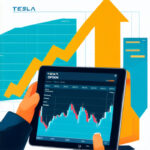A Comprehensive Guide to Understanding the Tesla Stock Share Price

Getting Acquainted with Tesla’s Stock Price
When we bring up the topic of the “Tesla stock share price,” we’re really diving into a market trend that has grabbed the attention of investors around the globe. Tesla isn’t just leading the pack in automotive and renewable energy—it’s shaking things up with revolutionary innovations, which, unsurprisingly, has led to some wild ups and downs in its stock price. Whether you’re a seasoned investor or just curious about the buzz, this guide will help you unravel the mystery behind Tesla’s market value. We’ll chat about what the Tesla stock share price means, why it matters, and how the company’s new ideas continue to shape market vibes. So, whether you’re eyeing potential investments or just keeping tabs on market trends, nailing down these basics is key to making savvy decisions.
Think of Tesla’s stock price as more than just a number on your trading app—it’s a snapshot of investor confidence, cutting-edge tech breakthroughs, and a whole lot of market optimism. As Tesla pushes the envelope in electric vehicles and clean energy, every market move is closely watched. With the company’s influence felt all over the globe, understanding what factors drive that share price can offer some serious insight for your investment plans. In the next few sections, we’ll dig into historical trends, external influences, and even future projections, offering you a detailed yet easy-to-digest look at Tesla’s stock story.
So, What Exactly Is Tesla’s Stock Price?
At its most basic, the Tesla stock share price is simply the current market value at which shares of Tesla, Inc. are being traded. But don’t be fooled by its simplicity—this number carries a lot of weight, encapsulating everything from investor moods and market cycles to the company’s actual performance. The continual ebb and flow of this figure is swayed by a whole bunch of factors, from quarterly reports to broad economic trends. Each time you notice a shift, it’s a real-time pulse on how investors view Tesla’s potential, risks, and overall market scene.
Why Tesla’s Stock Price Matters
For lots of investors, the Tesla stock price is a pretty big deal. It acts as a live barometer of how the market sees not just Tesla’s current chops, but its future promise too. Whenever there’s a big news dump, policy change, or even a global event, the stock price often reacts in kind. Traders use this metric to gauge volatility, manage risks, and tweak their long-term game plans. By keeping an eye on these fluctuations, you can really empower yourself to make decisions that are both informed and smart.
An Overview of Tesla’s Market Clout
Tesla has carved out its own little corner in a crowded market. Its influence jumps out not only in the automotive world but also in renewable energy, battery tech, and even artificial intelligence. With a charismatic leader steering the ship and a reputation for breaking the rules, Tesla has become a trendsetter for future tech trends. Its stock price is often seen as a kind of health check for sectors tied to clean energy and innovation. But remember, Tesla’s performance isn’t just about the numbers; it’s also a story of disruption and bold moves that inspire similar advances across various industries.
Tracing Tesla’s Stock Price Journey Through Time
To really get where Tesla stands today, it helps to rewind and look back at its history. Tesla’s stock journey is a roller coaster of dramatic twists—filled with important milestones, critical decisions, and even some market overreactions along the way. From its early public debut to those jaw-dropping price jumps after groundbreaking announcements, the history of Tesla’s stock is a lesson in itself. By examining these patterns, investors can see not only how the company has grown but also how market moods have shifted over time.
Looking back, you can spot clear phases of explosive growth, bouts of volatility during economic slumps, and resilient recoveries after downturns. Every peak and valley tells a part of the story, revealing how investor expectations and external influences have played a big part. As we piece together historical performance, it’s clear that Tesla’s journey is as much about disruptive innovation as it is about weathering market skepticism. Each milestone along the way brings fresh insights into risk management, evolving market dynamics, and long-term value creation.
Big Moments That Shaped Tesla’s Stock Price
Tesla’s path has been marked by key milestones that have had a major impact on its stock price. Starting with the initial public offering, every phase of growth came with its own set of challenges and opportunities. For example, launching exciting new electric models, branching out into international markets, or nailing improvements in battery technology have all nudged the stock price upward at times. On the flip side, any hiccups—like production delays or regulatory headaches—sometimes led to sharp drops. Each of these moments tells a piece of the story of a company trying to balance cutting-edge innovation with the inevitable growing pains.
Getting a Handle on Historical Performance Data
When you dive into Tesla’s historical data, it’s important to not just look at the raw numbers but also the context around each change. Breakthroughs in technology, strong financial reports, and major market announcements have at times sparked investor enthusiasm. Meanwhile, broader issues like economic downturns or regulatory bumps have occasionally put a damper on sentiment. By sifting through this data carefully, experienced investors can pick up patterns that might hint at future moves. Essentially, past performance offers a glimpse into the company’s journey—a way to anticipate how it might react to future market news or global trends.
Lessons From Past Market Swings
The ups and downs of Tesla’s stock price have taught plenty about market psychology and risk management. Investors have learned that market moods can flip quickly based on both in-house company shifts and larger economic events. Watching Tesla ride both periods of explosive growth and sudden corrections serves as a reminder to be patient and do your homework. It’s a clear sign that a stock’s number isn’t just about the company’s wins; it’s also a reflection of the global investor mindset. These lessons have encouraged a more measured, strategic way of investing, emphasizing that while the rewards can be high, so can the risks.
The Factors Driving Tesla’s Stock Price
Tesla’s stock price is the result of a complex mix of factors, from market mood swings to major global economic shifts. Breaking down these elements can really help investors understand why the stock behaves the way it does. Beyond what happens inside the company, external factors like investor sentiment, technological breakthroughs, and even geopolitical events weigh in heavily. In the next section, we’ll explore both internal and external forces that shape Tesla’s valuation and offer insight on how investors respond during times of both uncertainty and optimism.
It’s no secret that market sentiment is a huge driver of stock prices, and this is especially true for Tesla. Investor behavior, new tech advances, and shifts in the world economy all contribute to that delicate balance of supply and demand. This interplay can lead to rapid market reactions—sometimes upbeat, sometimes not so much—whenever new information breaks. Grasping these dynamics is vital, particularly for those who want to stay ahead of the curve in their investments. As you read on, you’ll see how these key factors work together to influence not only Tesla’s current valuation but also its future direction.
How Market Sentiment and Investor Behavior Shape Tesla
At the core of any stock market is the sentiment of its investors. With Tesla, that sentiment is a cocktail of excitement, a dash of skepticism, and a whole lot of optimism. The stock price often mirrors these mixed emotions—soaring after bold announcements or taking a nosedive when doubts creep in. When investors are pumped up by positive media buzz or strong performance numbers, the stock tends to climb. On the other hand, negative news or uncertainty can lead to sharp falls. Getting a handle on these patterns is key to understanding the ups and downs in Tesla’s market performance.
How Technological Breakthroughs Impact Tesla’s Stock Price
Tesla isn’t just another car manufacturer—it’s a true tech innovator. Its relentless drive to adopt and perfect next-gen technologies has a big influence on its stock price. Whether it’s breakthroughs in autonomous driving or leaps in battery efficiency, every new development boosts investor confidence. These tech advances don’t just shake up the automotive scene; they set new standards across the tech industry. So naturally, when Tesla unveils something new, it often signals a confidence boost, reinforcing its image as a leader in innovation.
The Role of Global Economic Shifts
Economic conditions around the world play a significant role in tinting the “Tesla stock share price.” Changes in things like inflation rates, currency values, or international trade policies can really sway investor sentiment. Even a company as robust as Tesla isn’t immune to the bumps of global economic cycles. In turbulent times, you might see a bit more fluctuation in its stock as investors adjust their risk calculations. Likewise, bouncing back during economic recoveries can give the stock a helpful lift. In this way, Tesla’s market value serves as a kind of mirror, reflecting not just its own performance but also the broader financial climate.
Tesla vs. the Rest: A Comparative Look
Sometimes, to truly understand Tesla’s stock price, it helps to compare it with industry peers and other tech giants. Tesla’s performance tends to stand out thanks to its high volatility, rapid growth, and trailblazing innovations. When you place it alongside more traditional players, the contrast just jumps off the page. This comparative analysis not only highlights Tesla’s competitive edge but also its inherent challenges in a fast-moving market.
Analysts often point out that looking at Tesla next to its peers reveals what really sets it apart. Its strong brand, cutting-edge technology, and bold business model create a distinctive picture of wild price swings—sometimes offering high returns, other times a steep drop. Understanding these differences helps in setting realistic expectations and strategies, ensuring your portfolio captures both the promise and the pitfalls that come with high-growth stocks like Tesla.
Weighing Tesla Against Other Industry Leaders
When you line up Tesla’s stock price against that of other industry heavyweights, the differences in volatility and growth potential become pretty clear. Traditional automakers might offer steady, predictable trading figures with a bit of a safety net, but Tesla’s fast-paced, ambitious expansion keeps investors on their toes. For instance, while some companies provide steady dividends, Tesla attracts those who believe in a future of market disruption. This contrast is crucial when evaluating a company’s overall performance. It sheds light on the kinds of risks and rewards you might face when betting on innovation.
Breaking Down Tesla’s Performance Metrics
When it comes to gauging Tesla’s performance, it’s all about looking at the full picture—from earnings and revenue growth to profit margins. Seasoned investors scrutinize these figures to decide whether the stock is overvalued or ripe for growth. Tesla’s metrics often underscore its rapid expansion and technological feats, which can drive the share price up. Still, these impressive numbers come with their own bundle of risks, particularly in the face of mounting competition and operational challenges. Weighing these metrics carefully can help you balance potential rewards against the inherent risks in your investment decisions.
Understanding the Ups and Downs: Tesla’s Competitive Edge and Risks
Tesla’s competitive advantages are as remarkable as they are unique. Its strong brand, focus on sustainability, and relentless innovation have cemented its market niche. However, these strengths often come with a side of risk, from hefty research investments to production bottlenecks that can temporarily dent performance. By keeping an eye on both the bright spots and the warning signs—like regulatory challenges or economic shifts—you can get a well-rounded view of Tesla’s stock behavior compared to competitors. This balanced perspective is key to understanding both the opportunities on the horizon and the challenges that lie ahead.
Looking Ahead: What’s Next for Tesla’s Stock Price?
Casting an eye to the future, experts are both excited and cautious when it comes to predicting Tesla’s stock price. With its rapid pace of innovation and ever-growing market footprint, figuring out Tesla’s next move isn’t a walk in the park. Analysts lean on predictive analytics and complex models that consider everything from new technology trends to global economic conditions. While the promise of future breakthroughs is enticing, challenges such as market saturation and regulatory snags could always temper expectations. As you navigate the world of forecasts, it’s important to recognize the uncertainties and the many moving parts that can influence future share prices.
For those watching Tesla closely, the future is likely to be shaped by ongoing innovation mixed with external economic pressures. Forecast models suggest that while some volatility is inevitable, long-term optimism could prevail thanks to Tesla’s pioneering role in electric vehicles and sustainable tech. For investors, these predictions are a valuable map, but they should always be approached with a healthy dose of caution—pairing technical analysis with global market insights.
Forecasting Tesla with Predictive Analytics
The use of predictive analytics when it comes to Tesla’s stock price has really taken off recently. Experts now mix historical data, investor sentiment, and emerging tech trends to forecast what might be around the corner. This combo can help point out when a rapid upswing or potential correction might occur. Although nothing in the financial world is set in stone, these evolving data tools offer intriguing insights that balance hopeful projections with market realities.
Riding the Wave of Innovation and Expansion
Tesla’s bold moves into new markets and its non-stop chase for innovation are major engines driving its unique market stance. As the company dives into advancements like autonomous driving, improved battery tech, and international expansions, its potential for growth seems boundless. Every new product or market venture becomes a milestone, pushing Tesla’s stock price upward and setting new industry benchmarks. While innovation isn’t without its trial-and-error moments, its overall effect on the stock has typically been a positive one over time. For fans and investors alike, these innovations are seen as the solid foundation for sustained growth and market disruption.
Navigating Future Challenges and Opportunities
Looking forward, Tesla faces a mix of obstacles—from regulatory hurdles to fierce competition in the electric vehicle arena. Yet, these challenges also open up exciting opportunities, especially as the push for sustainability gathers pace worldwide. Tesla is expected to keep breaking barriers while adapting to an ever-shifting market landscape. For investors, this means preparing for periods of wild swings and substantial growth alike. Staying ahead in this environment calls for a proactive mindset and a sharp eye on emerging trends. Balancing these challenges with the opportunities on offer can help you confidently navigate the evolving market dynamics.
Crafting Your Investment Strategy Around Tesla Data
Tesla’s dramatic journey through the market has spurred a wide array of investment strategies designed to suit different risk appetites. Whether you lean towards a long-term approach focused on steady growth or prefer short-term plays that ride on volatility, Tesla’s stock data offers a treasure trove of insights. With a firm grounding in historical trends and predictive analytics, investors can tailor strategies that are both resilient and flexible. Every investor’s risk tolerance is unique, and understanding these dynamics might just be the secret sauce between building a rewarding portfolio and getting caught in unexpected market swings.
Long-term investors often ride out the storms in hope of capitalizing on Tesla’s sustained upward trends driven by continual innovation. Others might opt for a more nimble short-term strategy, aiming to benefit from the stock’s notorious volatility. By keeping tabs on trend analyses and market sentiment, you can tweak your approach to align with global shifts and company-specific news. The bottom line is that a well-informed strategy—backed by thorough research into Tesla’s dynamics—can really enhance your returns while minimizing risks. Crafting your personal investment strategy is a bit like fine-tuning an instrument; it’s all about adjusting to the dynamic rhythm of the market.
Long-Term Investment or Short-Term Trading?
Deciding whether to play the long game with Tesla or dive into short-term trading depends largely on your financial goals and comfort with risk. Long-term investors are drawn to Tesla’s futuristic vision and persistent innovation, banking on the company’s continuous growth. Meanwhile, short-term traders often chase quick wins from the stock’s inherent volatility. Both approaches have their ups and downs—compound growth can reward the patient, while quick moves may require constant vigilance and rapid decision-making. Ultimately, your choice comes down to how much faith you place in Tesla’s long-term direction and what fits best with your investment timeline.

Laura Henderson is an enthusiast and has been writing on cutting-edge topics for years.







